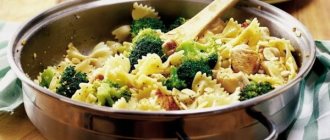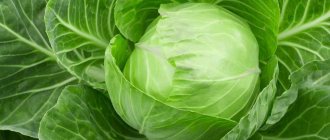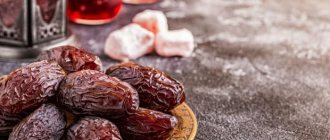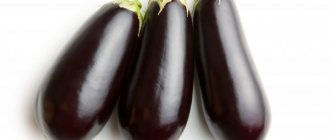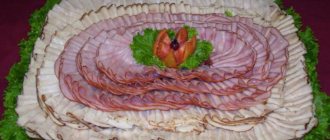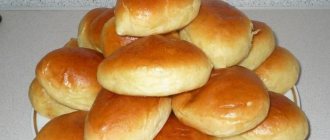The benefits of pasta products
Pasta products are presented in various types : spaghetti and cones, spirals and vermicelli, noodles and shells.
They have not only a variety of shapes and sizes, but also composition. For the production of pasta products, ordinary flour, flour from glassy and durum wheat can be used.
, a pasta made from durum wheat, has the greatest benefits
They contain:
- Tryptophan is an amino acid that provides good mood, good spirits and sound healthy sleep.
- Complex carbohydrates that completely replenish energy losses caused by intense physical activity and burn fat while preserving muscle tissue.
- Fiber , which lowers cholesterol levels in the blood, protects the heart and blood vessels from the development of a number of diseases and improves the process of food digestion.
Useful qualities
- As mentioned above, the healthiest pasta is made from durum wheat . They are a dietary product because they have a fairly low glycemic index, which means they satiate and satisfy the feeling of hunger for a long time. But it is better to completely remove products made from soft varieties of wheat from the diet, since they do not provide any benefit to the body, and often can even contribute to the gain of extra pounds.
- Fast and high-quality saturation is not the only advantage of good pasta. They are also very beneficial for the health of our digestive system, as they contain fiber and dietary fiber, which facilitate the process of digestion and absorption of food in the stomach.
- Fiber also helps cleanse the gastrointestinal tract and remove waste and toxins from the body.
- Pasta contains an incredible amount of vitamin B , which plays an important role in the functioning of our body. Vitamins of this group are involved in basic metabolic processes, regulate the activity of the digestive system, and also have a tremendous impact on the functioning of the nervous system and psyche. A lack of vitamin B in the diet can cause serious sleep disturbances, loss of energy and mood, chronic fatigue and more severe health problems.
- Ordinary “horns” contain tryptophan , an amino acid necessary for the prevention of depressive disorders and maintaining a good mood.
- The product is rich in tocopherol, known as vitamin E. This substance slows down the aging of the body, and also plays an important role in the functioning of the reproductive system in women (to the point that an insufficient amount of it in the diet can cause infertility). Bonus: tocopherol promotes healthy skin, hair and nails, and also significantly improves their appearance and condition.
- Iron contained in the product is necessary for the functioning of the circulatory system and maintaining normal hemoglobin.
- Coarsely ground pasta reduces cholesterol levels in the blood , which in the long term has a positive effect on blood vessels and the heart.
Useful material
Pasta has a unique property: it slows down aging. This is due to the fact that they contain the optimal amount of vitamins and vital minerals.
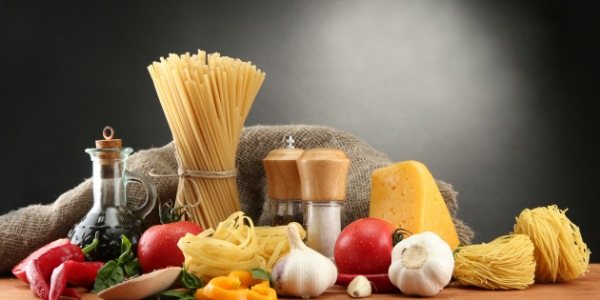
Vitamins
Pasta contains B vitamins, which stimulate the functioning of all systems and internal organs:
- B1 (thiamine) - necessary to ensure proper functioning of the central nervous system. It supplies the brain with glucose, increases mental activity, improves memory, normalizes the acidity of gastric juice, promotes the transformation of carbohydrates and other substances into the energy necessary for life, and improves immunity.
- B2 (riboflavin) is a substance that accelerates the absorption of nutrients and promotes the effective breakdown of fats. It is an active participant in the synthesis of proteins, hemoglobin and red blood cells necessary for the body, and also plays an important role in maintaining visual acuity.
- B3 (Niacin or nicotinic acid). Refers to the irreplaceable elements of energy metabolism. Relieves irritability, protects against insomnia and apathy, and helps maintain mental balance.
- B5 (calcium pantothenate or pantothenic acid) . It is considered one of the best vitamins for cellular metabolism. Increases tissue regeneration, protects mucous membranes and skin from infections.
- B6 (pyridoxine) is a component responsible for the production of serotonin. It is also called the “good mood vitamin.” It relieves insomnia, increases appetite, relieves irritability and eliminates symptoms of depression. Activates the process of formation of red blood cells and normalizes protein metabolism.
- B9 (folic acid) is a valuable component for the production of nucleic acids. Stimulates the synthesis of red blood cells, accelerates cell division. Ensures complete intrauterine development of the embryo.
Pasta also contains vitamin “beauty” A and vitamin “youth” E. They protect against excessive dry skin, the appearance of wrinkles and premature gray hair, and maintain visual acuity.
Video: “Is pasta healthy?”
Macronutrients
contained in pasta activate the functions of enzymes, stimulate the functioning of the hematopoietic organs , and promote active blood renewal. Thanks to them, the general condition of a person improves.
Pasta contains:
- Calcium. It influences the process of muscle contraction and excitability. Reduces the permeability of vascular walls and normalizes blood clotting. Has anti-inflammatory properties. Neutralizes allergic reactions.
- Phosphorus. Plays an important role in the formation of all types of tissue (bone, muscle, brain, nervous, etc.). Ensures normal functioning of the kidneys and liver.
- Magnesium. Ensures proper functioning of the kidneys during long-term use of diuretics. It has vasodilating and antispastic (antispasmodic) properties. Necessary for cardiac disorders. Stimulates the secretion of bile. Activates the gastrointestinal tract.
- Potassium. Transmits impulses from nerve endings to muscles, ensuring their timely stimulation and contraction. Maintains the water-salt balance of intracellular fluid. Stimulates cardiac activity.
- Sodium. Contained in the optimal concentration necessary for complete absorption of carbohydrates, transport of potassium, sugar, amino acids and production of hydrochloric acid in the stomach.
- Sulfur is a component of methionine, cystine and cysteine amino acids necessary for the formation of connective tissue and the synthesis of a number of proteins. It is part of keratin (an element of the skin of nails and hair) and insulin. This mineral increases the body's defenses.
Microelements
- Silicon is a mineral that slows down the aging process. It helps strengthen connective tissue, lower blood pressure, increase immunity and activate brain activity. Thanks to this microelement, the functioning of all systems is stabilized, the elasticity of blood vessels, muscles and ligaments is increased, and the likelihood of developing dermatoses and other skin diseases is reduced.
- Iron promotes the complete removal of heavy metal salts and other toxins from the body, increases the body's resistance to the effects of pathogenic bacteria, stimulates the thyroid gland, and increases the formation of hemoglobin.

Harm and contraindications

This occurs when consuming products made from wholemeal flour or lower (unrefined) varieties, as well as when adding protein to flour. They are based on starch.
The concentration of nutrients in such products is significantly lower than in spaghetti made from durum wheat.
Fat layers also appear when boiled pasta is combined with high-calorie sauces , fried meat, stewed vegetables, etc.
It is not recommended to eat instant noodles. It contains additives that speed up the cooking process and preservatives. They can cause gastrointestinal problems.
Nutritional value of pasta
If we talk about the calorie content of pasta, then on average this figure reaches 320–350 kcal per 100 grams of product in dry form. The difference in calorie content may vary slightly depending on the type of pasta and its recipe.
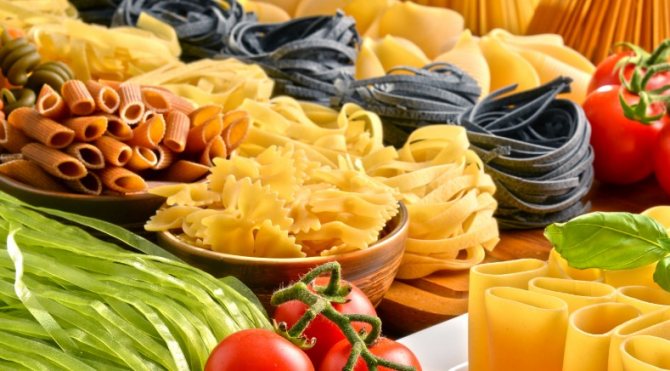
But a much greater difference is felt between semi-finished products and a ready-made dish, even if no oil or sauces are added to it. Ready-made pasta has a nutritional value 2.5–3 times lower. This is due to the fact that when cooked, pasta swells greatly, increasing in size. Therefore, one hundred grams of dry product and one hundred grams of cooked product have such different caloric content.
Calorie content of boiled pasta is 112 kcal per 100 g.
To understand what the energy value of the finished dish will be, just check the numbers on the pasta packaging and you can safely divide this figure by at least two. For example, if in dry form the calorie content of horns reaches three hundred calories per hundred grams, then in boiled form this figure decreases to 115 kcal.
But this approach does not work in the case of spaghetti or noodles, since they do not increase in size as much during cooking as other types of pasta.
With butter and cheese
Pasta itself is not very high in calories, but numerous additives that emphasize its taste add energy value to it and make it heavy on the stomach.
Nutritional value of classic cooking methods:
- Calorie content of pasta with butter - 160 kcal per 100 g;
- Calorie content of macaroni and cheese is 330 kcal per 100 g.
If horns with their modest calorie content are boiled in water with the addition of vegetable oil, their energy value immediately increases to 160 kilocalories
Cheese added to hot pasta will cause even more harm to your figure. The average calorie content of cheese reaches 350-400 kilocalories per 100 grams. This means that even ten grams of grated cheese can add about forty extra calories.
And if you monitor not only the calorie content of your dishes, but also the ratio of fats, proteins and carbohydrates, then cheese will cause irreparable damage to the fat content.
Navy pasta
The calorie content of Navy pasta is 330 kcal per 100 grams of product.
Also in our area they really like to add minced meat fried with onions to finished products. This simple dish is called “navy-style pasta.” Housewives love it for its ease of execution and pleasant taste, but do not forget about the calorie content. In this dish it reaches almost 300 kilocalories.
Calories and nutritional value
Contrary to popular belief, pasta is a product that burns fat rather than storing it in reserve. Their calorie content is 340 kcal/100 g.
They have high nutritional value due to carbohydrates. Every 100 grams of product contains more than 70%. Proteins account for 13%, and fats make up only 0.6%.
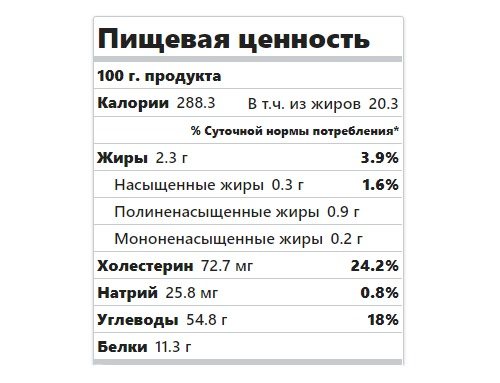
Secrets of serving dishes on the table
Culinary experts strongly recommend not rinsing cooked spaghetti, vermicelli, etc. with water, as this changes their taste.
And in order not to add butter to pasta, there is a little trick. While still cooking, add one tablespoon of vegetable oil, preferably olive, to boiling water. Yes, this will also affect the calorie content of the finished dish, but not as much as butter or vegetable oil, but added to already cooked products.
This trick will preserve the taste of the product, and at the same time the pasta will not stick to each other. But in order to delay the cooling time of the dish, you can resort to a method popular in Italy and preheat the plate before serving food on it. You can use a microwave oven for this purpose.
When calorie content is one of the most important factors in shaping your diet, you don’t need to immediately dismiss pasta based on its high energy value.
Pasta will allow you to enrich your menu with a large amount of complex carbohydrates that can energize you. This is especially important when a person supplements a nutritious diet with regular exercise. The carbohydrates received in the first half of the day will be more than enough for him even for an evening workout.
An important condition: pasta must be made from durum wheat, since it contains slow, not fast, carbohydrates. The body spends several hours on their assimilation, due to which the effect of vigor delayed over time is achieved.
Calorie content of premium boiled pasta
The calorie content of premium boiled pasta is 112 kcal per 100 grams of product.
Composition and beneficial properties of premium boiled pasta
There is no need to talk seriously about the beneficial properties of pasta; the advantages of this product are its availability and speed of preparation. You need to understand that pasta contains so-called “fast” carbohydrates, which quickly saturate, glucose instantly enters the blood, but the effect does not last long, after a while the brain again requires the supply of nutrients (calorizator). Boiled premium pasta has a high glycemic index, therefore it is not recommended for consumption by diabetics and according to the Dukan system.
Useful tips
The taste of pasta dishes depends on the quality of the products. A few practical tips will help you make the right choice.
How to choose
There is a misconception that expensive products are better than cheap ones. But this is the most common mistake. Many well-known manufacturers increase prices for brand and packaging.
Therefore, the quality of pasta should be assessed by its composition and other characteristics:
- Type of flour. The maximum amount of useful substances is contained in flour from durum wheat (group A pasta). Soft flour made from glassy wheat (Group B pasta) also contains a large amount of minerals and vitamins. The highest grade of flour for baking bread (it is used to produce
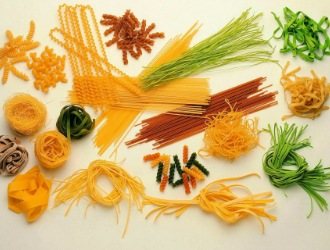
Group B pasta) is obtained by refining. The cleansing process destroys minerals and vitamins, depriving the product of its beneficial properties. - Pasta color. Durum products have a golden, amber-yellow or creamy hue. White or pale yellow pasta is made from regular bread flour with added coloring.
- Surface . For quality products it should be smooth, with a glassy fracture.
- Package . Pasta must be packaged in transparent, hermetically sealed packaging. Colored packs must have a window for visual assessment of the condition of the product. The expiration date of the product and the type of flour are marked on the packaging.
How to store
The shelf life of pasta without additives is three years, products with spinach or carrots are two years, and egg-based products are one year.
Pasta should be stored in a dry place, in the manufacturer's packaging. Once opened, the shelf life of the product is reduced.
Video: “How to cook pasta correctly?”
How to use
You can prepare many different dishes from pasta. This can be a separate dish (for example, casserole, navy pasta, pasta, etc.) or a side dish for meat.
They are first boiled in salted water. Then fry, bake, add your favorite sauce.
It is important to know! Ketchup, mayonnaise, and hot seasonings are high-calorie foods. They contain ingredients that increase appetite. Their combination with pasta leads to eating portions larger than the body needs to replenish energy costs. And this is a direct path to fat deposition in problem areas.
Types of pasta, benefits and calorie content
There are several criteria by which pasta is classified: the main ones are the composition and shape of the product. The taste, appearance, beneficial properties and cost of the finished product depend on the raw materials and technologies that were used in its manufacture.
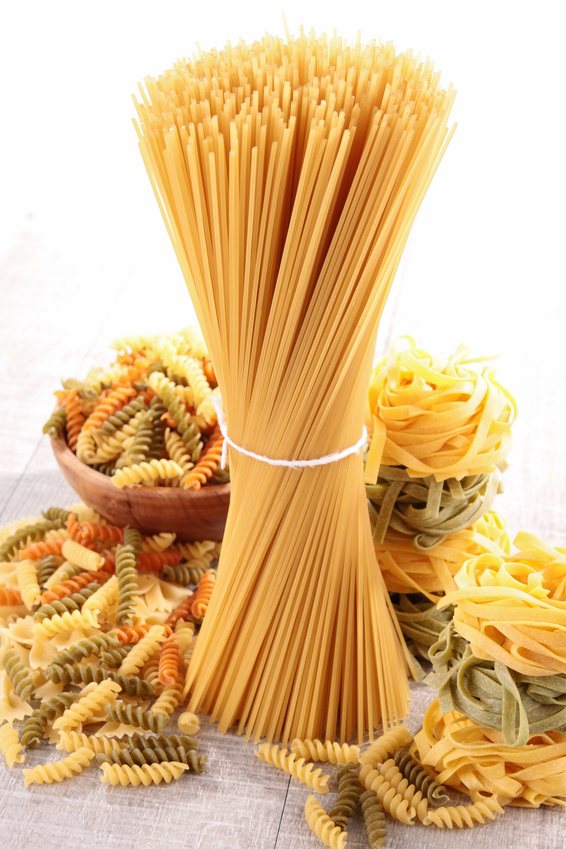
1. Shape According to their appearance, pasta is divided into 5 volumetric groups: long, short, small, curly (bows, shells, horns) and filled pasta. Separately, it is worth highlighting pasta made from wholemeal flour, intended for dietary nutrition: usually such pasta has a brownish-gray color.
2. Composition The recipe for classic pasta is simple - water and flour. But why then are some pasta healthy, while others are harmful to health and contribute to weight gain?
The quality and usefulness of pasta depends, first of all, on the flour that goes into their production. According to the standards in force in Russia, there are three groups of pasta: A, B and C. The first category includes pasta made exclusively from wholemeal flour: it is obtained from durum wheat (most often the durum variety). Class B pasta is made from glassy flour of soft grains. Group B includes products made from baking flour.
Pasta that belongs to category A is the healthiest and lowest in calories. They retain vitamins and minerals, provide the body with fiber and complex carbohydrates - substances that help get rid of toxins and keep you feeling full for a long time.
The flour from which class B pasta is made is devoid of most beneficial components. In addition, it contains a lot of harmful amorphous starch. And the baking flour that goes into the production of category B pasta is a completely purified, and therefore completely useless, product.
In some European countries, particularly in Italy, pasta is made only from healthy durum varieties of cereals, and this is monitored at the legislative level. Everything else is considered counterfeit. It's a pity that our government is not so strict about pasta.
The benefits of durum wheat pasta
Whole grain pasta retains all the beneficial properties of cereals. Thanks to complex carbohydrates that break down slowly, maintaining a feeling of fullness for a long time and not being deposited as fat in “problem areas”, they are safe for your figure. People get fat not from pasta, but from the additives with which they are eaten - from high-calorie sauces, butter, cheese and mayonnaise.
Pasta made from durum wheat is a source of natural fiber, vegetable protein, vitamins E and group B. Among the trace elements they contain iron, manganese, potassium, and phosphorus. Vegetable protein in pasta is a supplier of tryptophan, an amino acid involved in the production of the “happy hormone” serotonin. That's why it's good to eat pasta when you're feeling blue.
Calorie content
100 g of dry durum wheat pasta contains about 330-350 kcal. Boiled pasta has a lower calorie content - 100-125 kcal per 100 g of product; nutritional value: carbohydrates – 70 g, proteins – 10 g, fats – 1 g per 100 g of product.

